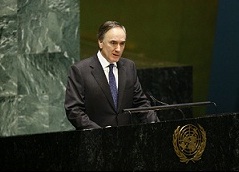Permanent Mission of Greece to the United Nations  News
News Introduction by HE Ambassador A. Mitsialis of draft Resolution on the Return or Restitution of Cultural Property to the Countries of Origin
Introduction by HE Ambassador A. Mitsialis of draft Resolution on the Return or Restitution of Cultural Property to the Countries of Origin
 News
News Introduction by HE Ambassador A. Mitsialis of draft Resolution on the Return or Restitution of Cultural Property to the Countries of Origin
Introduction by HE Ambassador A. Mitsialis of draft Resolution on the Return or Restitution of Cultural Property to the Countries of OriginIntroduction by HE Ambassador A. Mitsialis of draft Resolution on the Return or Restitution of Cultural Property to the Countries of Origin
Wednesday, 12 December 2012

I am pleased to introduce also on behalf of the cosponsors draft resolution L.34, entitled “Return or restitution of cultural property to the countries of origin”, which we trust that will be unanimously endorsed by the General Assembly.
At the outset, I would like to thank the Secretary General and the Director General of UNESCO for their comprehensive report on the return or restitution of cultural property to the countries of origin. This report outlines the most significant developments that have taken place during the last years in the field of the return or restitution of cultural objects to the countries of provenance. The 40th anniversary of the 1970 Convention on the Means of Prohibiting and Preventing Illicit Import, Export and Transfer of Ownership of Cultural Property and the increasing number of countries that accede to this instrument, which now amount to 123 States Parties, the outstanding work of the Intergovernmental Committee for Promoting the Return of Cultural Property to its Countries of Origin or its Restitution in case of Illicit Appropriation, and the continuing commitment of UNESCO to the attainment of this end are only a few of the recent positive steps in the fight against illicit traffic of cultural property.
In the years since the General Assembly adopted Resolution 64/78 entitled “Return or restitution of cultural property to the countries of origin”, major developments have seen the day. The draft resolution contained in document number A/67/L.34 reflects the state of play in this field.
A major step in the effort of return or restitution of cultural property has been the convening of the second meeting of States Parties to the 1970 Convention on the Means of Prohibiting and Preventing the Illicit Import, Export and Transfer of Ownership of Cultural Property in June 2012, in Paris; the adoption of the Rules of Procedure of this Meeting contained two important decisions, namely the decision to convene every two years, granting, in this way, a necessary periodicity in the meetings, and the creation of a Subsidiary Committee, tasked to promote the purposes of the Convention. More specifically, the Subsidiary Committee will, inter alia, review national reports, and prepare and submit to the Meeting of States Parties guidelines aiming at improving the implementation of the 1970 Convention.
Mr. President,
Despite concerted international efforts to tackle the problem, illicit traffic of cultural property continues to pose a serious threat to cultural heritage of States. This threat is higher in situations of crisis and conflict, when cultural objects are often smuggled outside their countries of origin. The draft resolution under consideration today condemns recent attacks to World Cultural Heritage Sites and calls for an immediate end to such acts, by reminding States Parties to the Convention for the protection of cultural property in the event of armed conflict, of their obligations contained therein.
Awareness raising and capacity building are critical for the success of the efforts undertaken in the context of return or restitution of cultural property to the countries of origin. As it is highlighted in the draft Resolution, UNESCO, along with INTEPOL, UNIDROIT and other major stakeholders, continues to drive a systematic campaign to increase the visibility of the available tools and organize joint action for the effective protection of cultural heritage. Furthermore, the draft resolution welcomes the presentation of Model Legislative Provisions on Undiscovered Cultural Objects which is another important step towards combating the phenomenon of illegal excavations and ensuring the property of unearthed archeological objects. Moreover, interaction with the international art market in view of improving practices in various areas of expertise such as provenance, investigation, ethics and procedures of restitution proves to be of paramount importance.
Recent restitution cases, either in the framework of the 1970 Convention or under the aegis of the Intergovernmental Committee, show that fostering international cooperation lies in the heart of the solution. The restitution of 21.000 coins, jewels and other artifacts from Canada to Bulgaria, that have been illicitly imported to Canada and seized by the Canadian Police, and the restitution of the Bogazkoy Sphinx to Turkey, to mention only two cases, are clear examples of successful use of available tools, whether legal instruments or bilateral agreements.
Mr. President,
Cultural heritage is the mirror of a country’s history, thus lying within the very core of its existence, since it represents, not only specific values and traditions, but also a unique way a people perceives the world. Whether it is a Makondé Mask, an Etruscan vase or a Parthenon frieze, they all are a testimony of a nation’s path into time. But in order for them to continue to serve their artistic, aesthetic and social raison d’être, they must be protected against illicit acts and use and, in such cases, to be restored and returned in their natural environment, outside of which they can no longer inspire the collective conscience of humanity. This is precisely the reason for which the objectives of this resolution should leave no State indifferent.
Thank you, Mr. President.














